Diseases and pests of trees
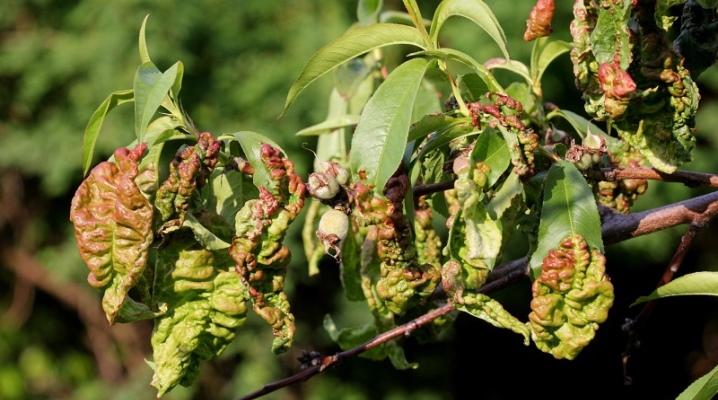
Many gardeners and gardeners plant trees on their plots, in addition to vegetable crops. Most often, ornamental conifers are used, which serve as a decorative decoration of the garden, as well as various fruit plants. Often, this vegetation suffers from various diseases and pests. Today we will talk about how to treat such trees.
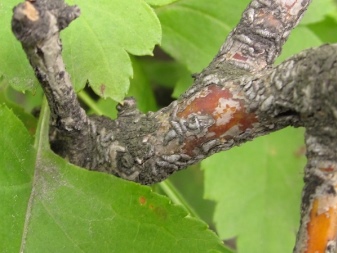
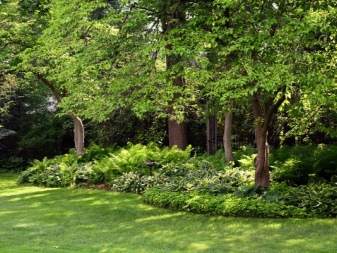
Symptoms and treatment of coniferous tree diseases
These plants will be able to decorate almost any area. But when infected with parasites and diseases arising from bacteria and viruses, they easily lose their attractive appearance. Among the main symptoms that determine that the trees are damaged, the following can be distinguished:
- the appearance of rot on fruits and wood;
- deformation of various parts of the plant;
- the appearance of neoplasms on the trunks;
- change in the color of the needles;
- the presence of a light bloom on the surface of the vegetation.
The needles often become brown, this means that it has been damaged by a fungus, various harmful bacteria. Sometimes this symptom occurs in cases where environmental conditions negatively affect the trees. Rust on needles can also occur due to the action of various fungi. It represents spots of orange, yellow-brown brown color. However, they can later appear on the trunk. Because of these colors, the disease received such a name.
With the defeat of conifers powdery mildew a thin white bloom will appear on the seedlings, which will begin to thicken over time. At blotches on the surface of the plant, it will be possible to observe the appearance of spots of different sizes and different colors. Bark necrosis can cause the death of parts, which will be accompanied by a change in color. In addition, conifers are often damaged by various harmful insects and parasites... Among them are bark beetles, pine aphids. These organisms also lead to a change in the color of the needles and bark, the appearance of plaque. There are many ways that you can fight diseases and pests on conifers.
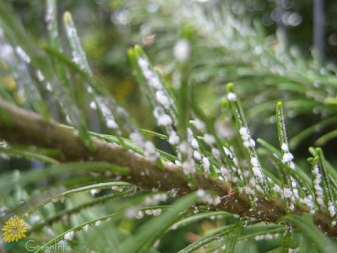
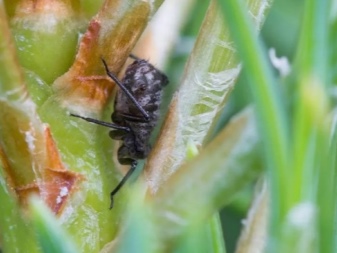
Let's analyze the main ones.
- "Alatar". This drug belongs to insecticides. It is a means of complex action, the remedy makes it easy to fight various insects, it does not immediately kill them, at first it leads to the fact that the parasites cannot eat, and then they develop a nervous paralysis, which leads to early death. "Alatar" will not be washed off the vegetation surface even after heavy rain. Also, this tool will not decompose under the influence of ultraviolet radiation. As a rule, solutions are made with such a preparation and the diseased areas of conifers are sprayed with the resulting compositions.
- Colloidal sulfur. This substance does not dissolve in water, it forms a special suspension with it. The composition is available either in the form of a powder or in the form of a paste. Colloidal sulfur (40 grams) is mixed with 50 milliliters of water, and then thoroughly ground in such a way that the result is a mushy mixture. After that, add a little more water, and all this is applied to the diseased areas. In this case, the procedure is best done in the morning.
- Bordeaux liquid... Such a medicinal composition for conifers is a simple solution of copper sulfate in lime milk. This liquid allows you to effectively fight fungus and various bacteria. It must be mixed with clean water and mixed thoroughly. The resulting composition will be quite "aggressive", therefore, when working with it, it is better to immediately put on all the necessary personal protective equipment. Remember that after spraying with such a substance, a slight blue coating may remain on the trunks. Bordeaux liquid must never be mixed with other chemicals.
- Hom. Such a preparation for trees is a fungicide that destroys pathogens. It is absolutely safe for humans and crops in the garden.
But at the same time "Hom" does not adhere well to the leaf blades; during precipitation it will simply be completely washed off from them.

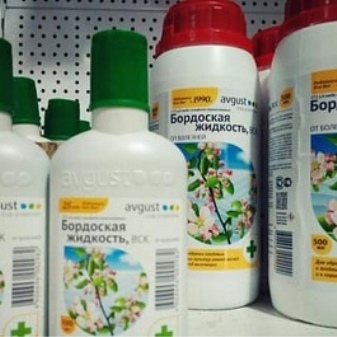
Diseases of fruit trees and methods of control
Fruit trees often suffer from various diseases caused by bacteria and viral pathogens. All diseases can be divided into two large groups.
Infectious
This category includes cancer of the root system, in which the roots of vegetation are affected.... In this case, large growths appear, which are destroyed in the autumn period of the year. At the same time, every year the neoplasms will only begin to grow larger. If you notice cancer on the roots of young seedlings, you need to be sure to prune them back to healthy parts. After that, the trimmed areas are dipped in a solution of copper sulfate and everything is left in this form for 10-20 minutes. Then mineral fertilizers are applied to the soil. They do this in order not to infect neighboring crops and trees.
Scab can also be classified as infectious.... It infects leaf blades and tree fruits. To fight it, you can use a solution of ferrous sulfate, which is sprayed on diseased areas. But the procedure is recommended to be carried out before the beginning of the flowering period. In addition, remember that the fungus that causes this disease is in the fallen leaves, so you need to get rid of them in a timely manner. It is best to burn them completely.
In case of damage to vegetation fruit rot putrid areas appear on the fruits, you can also observe a white bloom. Later, soft large spots of dark brown color appear. Ripe fruits begin to fall off much ahead of time, or simply dry up right on the fruit tree. Leaves may begin to curl. In this case, the best option would be to use a solution of ferrous sulfate (5%). In this case, spraying with the substance should be carried out even before the opening of the kidneys. Any dried or damaged branches will need to be cut and burned completely.
Sometimes stone fruits are affected hommosis... In this case, trunks and skeletal branches will be damaged. Over time, a dark liquid will begin to flow out of them. Later, large cracks will begin to form.
To combat such a disease, you must first thoroughly clean out all the wounds on the surface of the wood, and then treat it all with a solution of copper sulfate.
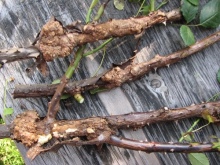

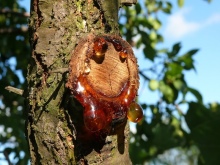
Often, fruit vegetation suffers from a disease such as moniliosis... This fungal disease leads to the fact that sluggish flowers begin to appear on the trees, which then begin to fall off ahead of time. It will also be possible to observe that the leaf blades begin to acquire a darker color, the fruits turn brown over time. With such a lesion, the use of special fungicides will be the best option.
When fighting insects, you can use various folk remedies that can be easily prepared at home.
- Broth with tobacco dust... To prepare this medicinal composition, it will be necessary to mix 200 grams of such dust with heated water, all this mixes well.Then all this is infused for several days, filtered. After that, the finished substance can be sprayed on diseased plants on the site.
- Hot pepper infusion... This remedy can help in cases where fruit trees have been damaged by aphids and small caterpillars. To prepare it, you will need to mix 100 grams of dried pepper pods with water (one liter). All this is put on fire and boiled. After that, the resulting composition must be cooled, poured into another clean container. In this form, everything is infused for two days, and then all this can already be sprayed with diseased vegetation.
- Infusion with dry mustard. To prepare this healing composition, you will need to mix mustard powder (100 grams) with warm water (10 liters). All this is sent to infuse for two days, and later the solution is diluted a little more with cool water. After that, you can use the ready-made tree spraying agent.

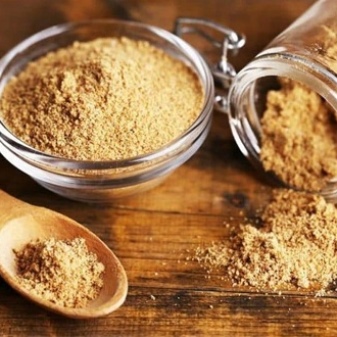
Non-infectious
Such diseases appear under the influence of unfavorable external conditions.
- Anthropogenic factors. These include excessive air and soil pollution with various industrial wastes, as well as the use of large amounts of pesticides and other harmful components.
- Soil and climatic factors... This group includes the imbalance of nutrients in the soil, the effect of drought, frequent precipitation, winds. Burn spots may appear on the leaves.
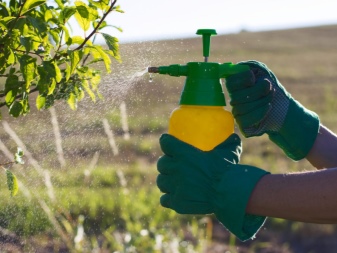
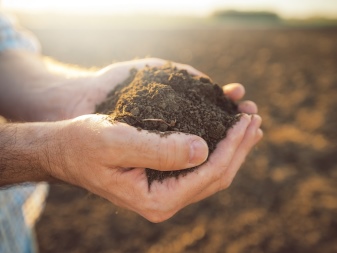
Diseases of ornamental trees
Often, various decorative plantings on the site also suffer from pests and diseases. Powdery mildew is the most common disease among deciduous plants. It arises from the action of special mushrooms from the class of marsupials. When powdery mildew appears, moldings and young shoots first begin to be damaged. In this case, you can immediately treat diseased vegetation with special chemicals.
Chestnut ornamental trees are also often affected - often from necrosis... With such a disease, the bark slowly dies off. Over time, it begins to crack strongly and become covered with small black or gray seals.
In case of necrosis, it will first be necessary to clean out the damaged areas of the wood with a garden knife. Then all this should be treated with ready-made bactericidal compositions.
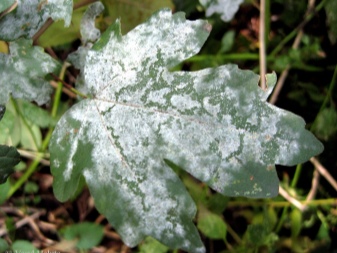

Description of pests and control measures
Among the main pests that affect trees in gardens and vegetable gardens, the following varieties can be distinguished.
- Grinder beetles. Such harmful insects have a strong chitinous shell, which allows them to fall from great heights and at the same time remain completely intact. These pests eat wood by damaging trees. The larvae of such beetles have well-developed legs; on their tips you can see small bristles, with the help of which it is easy to fix on vegetation. Grinders are white in color, they have a rather large head, which is completely covered with red bristles.
- Aphid... These parasites settle on plants in whole columns. They usually have an oblong body, its length can vary from 0.4 to 0.8 millimeters. Such small pests are gray, green or brown in color. They often have small tubercles and protrusions. They easily eat leaf blades of various trees and shrubs. As a result, swollen spots of yellow or orange color begin to appear on them.
- Medianitsy... These parasites are small lizards of gray or copper color. They are absolutely safe for humans, but at the same time they can cause significant harm to various plants. These pests begin to feed on young buds, and then begin to eat all the other parts. The larvae of the sucker begin to feed on the intensively young parts of the plants. They can switch to wherever there is still juice.Pests become active in early spring.
- Shields... Insects have special protective shields. Their oral apparatus is of a sucking type. They are able to easily suck out all the juices from fruit trees. At the same time, all sheet plates are covered with them. The scabbards have an oblong body. They secrete a special sticky liquid, which becomes a suitable environment for the appearance of harmful fungi, which leads to the rapid destruction of vegetation.
- Bedbugs... Most often they are green in color, sometimes brown individuals are found. Such insects may have colored stripes on their hard shell.
Garden bugs easily suck out all the juices from healthy plants, make large punctures in the leaves. Later, they can also settle on stems and fruits.
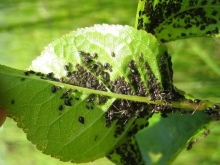
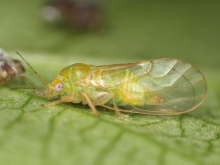
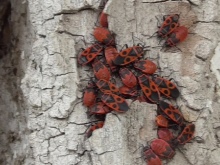
Other
In addition to the above harmful insects, trees can be damaged by many other parasites, including moths... The larvae in the form of small caterpillars are especially dangerous; they quickly damage a large number of healthy ripe fruits. When moths appear on the site, large brown soft spots with a bloom of the same color will begin to appear on the fruits. The damaged parts will quickly fall off or rot right on the tree itself.
Sometimes fruit trees can be damaged and glass cases... These butterflies have an oval body shape and are light brown in color. The larvae are simple, small caterpillars. The length of the insect can reach a maximum of 25 millimeters. Glaziers easily penetrate the branches of trees, making small moves. They feed on the core, in the cold season the pests go for the winter, but later return and continue to destroy the garden vegetation.
When fighting insects, you can use ready-made chemicalsthat will allow them to be destroyed. Earlier we considered such means as "Alatar", "Aktellik", "Fitoverm", "Aktara", "Vermitek". When preparing solutions with these components, it is necessary to familiarize yourself with the instructions in which it is written in what proportions the drug and water should be mixed. Most often, the resulting formulations can simply be sprayed on the diseased parts.
Also, in order to get rid of insects, some gardeners use and folk remedies against them, similar remedies can be made by yourself. Most often, various infusions and decoctions with wood ash, iodine, whey, hot pepper, other dried plants (dandelion, yarrow, plantain, walnut leaves). As a rule, the obtained formulations also carry out a simple spraying of diseased trees.
Often, special traps are made on insects, which are placed on the site. They can be bought ready-made in stores. Fumigation with the help of smoke.

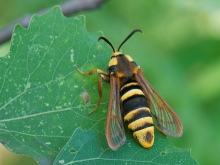
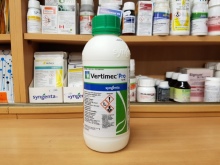
Prevention measures
To ensure reliable protection of garden plants from all diseases and pests, it is worth remembering the important basic rules for caring for them. Do not water the seedlings too abundantly. After all, waterlogged soil will be a suitable place for the development of fungi and bacteria. Periodically loosen and mulch the earth, dig (at least 10 centimeters deep). Various fertilizers are also important, which strengthen the plant's immune system. Also, do not forget that it is better to treat all plantings on the site in advance with different chemical preventive compositions. These treatments will be especially important in early spring before bud break. They should be carried out in June, and then at the beginning of autumn. You can also use folk remedies.
In this case, it is better to do the processing in the daytime. The best time is early morning. Some formulations can be applied in the evening. In any case, it is recommended to do everything in calm and dry weather. It is necessary to provide even contact of protective agents on the trunk, branches and leaves of trees.
Carry out regular diagnostics of seedlings in order to detect damaged areas in a timely manner. If you take proper care of your plantings, then they will be able to fully bear fruit and develop.
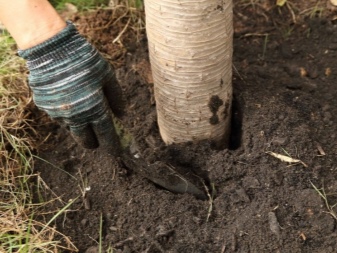














The comment was sent successfully.